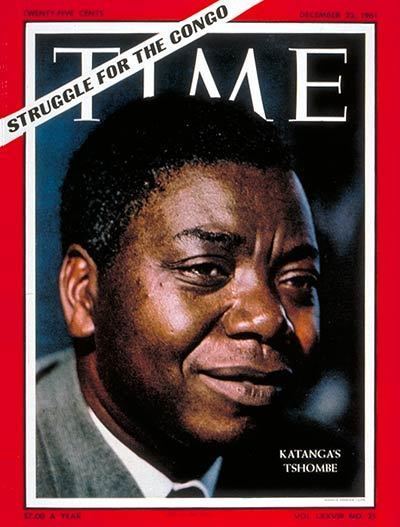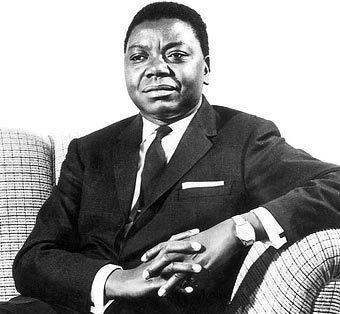Role Politician | Political party CONAKAT Succeeded by Evariste Kimba Name Moise Tshombe Resigned 1965 | |
 | ||
Similar People Joseph Kasa‑Vubu, Patrice Lumumba, Mobutu Sese Seko, Cyrille Adoula, Albert Kalonji | ||
Can 187 congolese politician moise tshombe arrives to london
Moïse Kapenda Tshombe (sometimes written Tshombé) (10 November 1919 – 29 June 1969) was a Congolese businessman and politician. He served as the president of the secessionist State of Katanga from 1960 to 1963 and as prime minister of the Democratic Republic of the Congo from 1964 to 1965.
Contents
- Can 187 congolese politician moise tshombe arrives to london
- Can 330 moise tshombe press conference
- Early life
- Political career
- Independence leader
- Later life
- Burial
- Fiction
- References

Can 330 moise tshombe press conference
Early life

A member of the Lunda tribes, Tshombe was born near Musumba, Belgian Congo, the son of a successful businessman. He received his education from an American missionary school and later trained as an accountant. In the 1950s, he took over a chain of stores in Katanga Province and became involved in politics.
Political career

He founded the CONAKAT party, with Godefroid Munongo; it promoted a federal Congo independent from the Belgian Empire.
CONAKAT won control of the Katanga provincial legislature in the May 1960 general elections. One month later, the Congo became an independent republic. Tshombe became President of Katanga.
In the resulting strife and chaos following independence, CONAKAT declared the State of Katanga's secession from the rest of the Congo. The Christian, anti-communist pro-Western Tshombe declared, "We are seceding from chaos." Favoring continued ties with Belgium, he asked the Belgian government to send military officers to recruit and train a Katangese army.
Independence leader
Tshombe demanded UN recognition for independent Katanga, and he announced that any intervention by UN troops would be met with force. Nonetheless, Congolese Prime Minister Patrice Lumumba and his successor, Cyrille Adoula, successfully requested intervention from UN forces. UN forces were sent under the direction of Irish representative (to Dag Hammarskjöld), Conor Cruise O'Brien.
Lumumba's government was overthrown, and Lumumba taken prisoner by Mobutu and detained at Camp Hardy in Thysville. Harold d'Aspremont Lynden (Belgian minister for African Affairs) sent a highly confidential telegram on 16 January 1961 to the government in Léopoldville (President Joseph Kasa-Vubu and Mobutu) to send Lumumba to Katanga. That would have stemmed from Lumumba's increasing popularity among soldiers, who might release him. Meanwhile, soldier mutinies and unrest increased by the day, at Prison Camp Hardy in Thysville. The telegram has still not been shown to exist.
While being flown in a Sabena DC-4 air plane to Katanga, Lumumba was beaten by the Congolese soldiers escorting him. In custody in Katanga, Lumumba was visited by Katangese notables and Belgian officers, who included Tshombe, Godefroid Munongo, Kibwe, Kitenge, Grandelet, Son, Gat, Huyghé, Tignée, Verscheure, Segers and Rougefort. Lumumba's execution was carried out by a firing squad led by a Belgian mercenary, Julien Gat.
Later life
In 1963, UN forces succeeded in suppressing Katanga, driving Tshombe into exile in Northern Rhodesia, later to Spain. In July 1964, he returned to the Congo to serve as prime minister in a new coalition government. Scarcely a year later, he was dismissed from his position in October 1965 by President Kasa-Vubu. In late 1965, General Mobutu, who had staged a successful coup against Kasa-Vubu, brought charges of treason against Tshombe, who again fled the country and settled to Francoist Spain.
In 1967, he was sentenced to death in absentia. On 30 June 1967, he was in a Hawker Siddeley jet aircraft that was hijacked by Francis Bodenan, a SDECE agent. According to the Congolese government, Tshombe was going to Africa.
Tshombe was taken to Algeria, jailed, and placed under house arrest. The pilots of the plane, Britons Trevor Coppleston and David Taylor, were released and returned to the United Kingdom. The Congolese government demanded his extradition to Congo, and his Western supporters agitated for his release. The Algerians resisted both demands. Tshombe died in 1969, the official cause of death was listed as "death from heart failure".
Burial
Tshombe was buried in a Methodist service at Etterbeek Cemetery, near Brussels, Belgium.
Fiction
Rumours and speculation following the 1968 landing of a mysterious aeroplane in Rhodesia, which was said to have been full of mercenaries and an ill Tshombe, were the basis for Daniel Carney's novel, The Thin White Line (1977, later retitled The Wild Geese), set in the Congo. The book was adapted as the film The Wild Geese (1978), starring Richard Burton, with a screenplay by Reginald Rose (author of 12 Angry Men). In the film, Winston Ntshona plays a pro-western, deposed African president, who is imprisoned following the hijacking of his plane.
